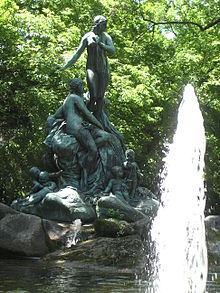Nymph garden
The Nymphengarten is a publicly accessible park in the city center of Karlsruhe .
location
The Nymphengarten begins at the far end of the new pavilion of the State Museum of Natural History , which formerly housed the Badische Landesbibliothek . The Federal Court of Justice begins on the western side of the area . The Nymphengarten is bounded to the east by the Lammstrasse.
history
As early as 1730, 15 years after the city was founded, the construction of the first park and garden began. The construction of this park in the style of an English garden was based on an idea of the city's founder, Margrave Karl Wilhelm von Baden-Durlach .
A few years later, the later Hereditary Prince Ludwig commissioned the garden inspector Friedrich Schweickardt, who was already responsible for planning the pheasant garden (see Pheasant Castle ), with the conversion of the garden into a pleasure garden . In 1788 the creation of the garden began and it was surrounded with a Ha-Ha . After completing the work, the park landscape was given the name Hereditary Prince Garden . The structure of the garden at that time no longer corresponds to the shape of the area today.
After the completion of the new building of the Natural History Museum by Karl Joseph Berckmüller in 1873 on the area of the Hereditary Prince Garden, the park was divided into Friedrichsplatz to the north and the southern part of the Nymphengarten.
Going back to an idea of the then horticultural director Friedrich Ries , a fountain was built at the southern end of the park area. The nymph garden was named after the nymph fountain created by Heinrich Weltring , which was set up in 1891. The fountain is a bronze sculpture that depicts several nymphs , some of which are completely unclothed .
The Gothic Tower and a small burial chapel with the sarcophagus of Hereditary Prince Karl Ludwig von Baden stood in the Nymphengarten until 1871 . Until 1944, the Amalienschlösschen, named after Margravine Amalie , stood in the western part of the park .
In the years 1880–1897, the Nymphengarten temporarily housed the Karlsruhe observatory before it was dismantled and moved to the Königsstuhl near Heidelberg .
literature
- Andreas Eiynck : A nymph by the sculptor Heinrich Weltring (1847–1917) in the Emsland Museum. In: Yearbook of the Emsland Heimatbund. Volume 38/1993, Sögel 1992.
Web links
- The nymph garden on the side of the city of Karlsruhe
- Information on the website of the City Center Citizenship
- Database of the cultural monuments of Karlsruhe
Coordinates: 49 ° 0 '22.1 " N , 8 ° 23' 58.4" E


